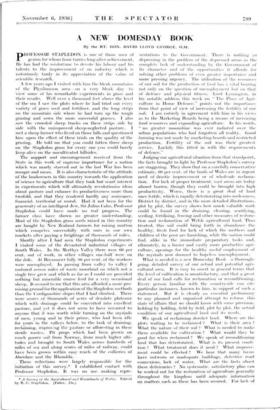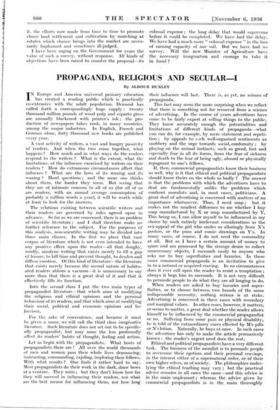A NEW DOMESDAY BOOK
By the RT. HON. DAVID LLOYD GEORGE, O.M.
PROFESSOR STAPLEDON is one of those men of genius for whom fame tarries long after achievement. He has had the misfortune to devote his labour and his talents to the improvement of an industry which is notoriously tardy in its appreciation of the value of scientific research.
A few years ago I visited with him the bleak mountains of the Plynlimmon area—on a very bleak day-4o -view some of his remarkable experiments. in grass and their results. Well over a thousand feet above the level of the sea I saw the plots where he had tried out every variety of grass seed and fertiliser, and the long strips on the mountain side where he had torn up the rough grazing and sown the more successful grasses. I also saw the crowded sheep tracks on these strips side by side with the unimproved sheep-neglected pasture. I met a sheep farmer who lived-on those hills and questioned him upon the effect of these trials on the quality of the grazing. He told me that you could fatten three sheep on the Stapledon grass for every one you could barely keep alive on the uncultivated hillsides.
The support and encouragement received from the State in this work of supreme importance for a nation which was nearly starved out in the last War has been meagre and mean. It is also characteristic of the attitude of the landowners in this country towards the application of science to agriculture that they took but scant interest in experiments which will ultimately revolutionise ideas about pasture and enhance its productiveness more than twofold, and that they rendered hardly any assistance, financial, territorial or moral. Had it not been for the generosity of an intelligent Jew, Sir Julius Calm, Professor Stapledon could have made no .real progress. The farmer class have shown no greater understanding. Most of the Stapledon grass seeds raised in this country are bought by New Zealand farmers for raising mutton which competes successfully with ours in our own markets after paying a freightage of thousands of miles.
Shortly after I had seen the Stapledon experiments I visited some of the devastated industrial villages of South Wales. In the Merthyr Valley there were 60 per cent. out of work, in other villages one-half were on the dole. • At. Brynmawr fully 90 per cent. of the workers were unemployed. In passing from valley to valley I motored across miles of waste moorland on which not a single tree grew and which as far as I could see provided nothing but miserable coarse feed for a very occasional sheep. It seemed to me that this area afforded a more pro- mising ground for the application of the Stapledon methods than the Cardiganshire slopes that I had climbed. There were scores of thousands of acres of desolate plateaux which with drainage could be converted into excellent pasture, and yet it does not seem to have Occurred to anyone that it was worth while turning on the myriads of men, young and in their prime, who had been idle for years in the valleys below, to the task of draining, reclaiming, improving the pasture or afforesting in these sterile wastes.• Pit props which had been grown on much poorer soil from Norway, from much higher alti- tudes and brought to South Wales across hundreds of miles of sea and --along scores of miles of railway; could have been grown -within easy. reach of the .collieries. of Aberdare and the Rhondda.
. These- reflections were • largely -responsible for the initiation of this survey.* I established contact with Professor Stapledon. It was no use making repre- 41 A Sui-rey of the" Agricultural ani i "astelandi of 'Inert. Fdited by R. G. Stapletion. (Faber. 15a.) sentations to the Government. There is nothing as depressing in the problem of the depressed areas as the complete lack of understanding by the Government of its character and of' the opportunities it affords for solving other problems of even greater importance and more pressing urgency. The utilisation of the resources of our soil for the production of food bus a vital bearing not only on the question of unc•mployment but on that of defence and physical fitness. Lord Lymington. in his notable addreSs this week on " The Place of Agri- culture in Home Defence," points out the importance from that point of view of increasing the fertility of our soil. I am entirely in agreement with him in his views as to the Marketing Boards being a means of increasing food resources and expanding agriculture. In his words.
" no greater moonshine was ever radiated over the urban populations who had forgotten all reality. Good farming was not made by marketing boards and restricted production. Fertility of the soil was their greatest. service. Luckily this fitted in with the requirements of defence."
Judging our agricultural situation from I hat. standpoint, the facts brought to light by Professor Stapledon's survey are staggering. They show that on a carefully conservative estimate, 60 per cent. of the lands of Wales are in urgent: need of drastic improvement or of wholesale reclama- tion. For lack of proper treatment, vast areas are today almost barren, though they could be brought into high productivity. Worse, there is a great deal of land once fertile, which is rapidly deteriorating into uselessness. District by district, and in the more detailed illustrations, plot by plot, the survey shows how much valuable work could be found in the draining, clearing, scarifying, seeding, fertilising, fencing and other measures of restora- tion and reclamation of Welsh agricultural land. Thus treated, this soil could bring forth in abundance the healthy, fresh food for lack of which the mothers and children of the poor arc famishing, while the nation could find, alike in the immediate preparatory tasks and. ultimately, in a busier and vastly more productive agri- culture, openings for the healthy useful employment of the myriads now doomed to hopeless unemployment.
What is needed is a new Domesday Book --a thorough- going, detailed survey of our actual and potential agri- cultural area. It is easy to assert in general terms that the level of cultivation is unsatisfactory, and that a great deal of our land calls for reclamation or reconditioning. Every person familiar with the countryside can cite particular instances, known to him, in support of such a statement. But it is dearly an essential preliminary to any planned and organised attempt to reform this state of affairs that we should know with some precision, holding by holding, field by field, plot by plot, the admit condition of our agricultural land and its needs.
We speak of reclaiming derelict land. Where are the plots waiting to be reclaimed ? What is their area ? What the nature of their soil ? What is needed to make them available for cultivation I What would they be good for when reclaimed ? We speak of reconditioning. land that has .deteriorated. What is its present condi- tion ? What treatment does it ,need ? What improve-- mad could be effected ? We hear that many I'm ins have outworn or inadequate buildings, defective road connexions, lack of water. What are the facts about these deficiencies ? No systematic. satisfactory plan can be worked out for the restoration of agriculture generally throughout the kingdom until adequate information on matters such as these has been secured.. For lack of it, the efforts now made from time to time. to promote closer land settlement and cultivation by snatching at estates which chance brings into the market are neces- sarily haphazard and sometimes ill-judged. .
I have been urging on the Government for years the value of such a survey, without response. All kinds of objections have been raised to counter the proposal—its colossal expense ; the long delay that would supervene before it could be completed. We have had the delay. We have had a much more " colossal expense " in the loss of earning capacity of our soil. But we have had no survey. Will the new- Minister of Agriculture have the necessary imagination and courage to take it in hand ?















































 Previous page
Previous page